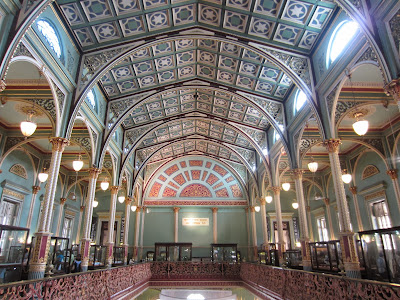Date: 25 October, 2013
Venue: Press Club of India, Glass House, Azad Maidan Fort, Mumbai
I was invited for a blogger's meet on "Save Our Tigers" by Aircel. Aircel in partnership with various Non-Government Organizations, conceptualized, designed and began impactful capacity building and awareness campaign on Saving Our Tigers in 2008. The slogan 'Just 1411 left, Save Our Tigers' awoke the conscious of the nation. Awareness of the plight of our national animal reached every corner and made people take notice. Aircel began active on ground work in late 2008 with WWF- India.
Here is a brief introduction to Tiger, (ref: The Illustrated Tigers of India, by Valmik Thapar).
Tigers: Zoologists and other animal experts call the majestic striped big cat commonly known as the tiger, Panthera tigris. Panthera is the name given to the group of four big cats in the world that have ability to roar with spine chilling effect: the tiger, lion, leopard and jaguar. The roaring is made possible by vibration of thickened vocal folds just below the vocal cords in the larynx. The origin of tiger trace back some fifty million years.
Threat to Tigers:
Around two thousand years ago, the Roman Empire was at its peak. Use of Caspian tigers in games and slaughters in amphitheatres introduced the first significant threat to the tiger's existence. One thousand years ago, Europe entered the Dark Ages. With people far less numerous and lethal than they are now, tiger populations maintained an equilibrium and enjoyed wide distribution.
The tiger population suffered unprecedented decimation when the proliferation of firearms and cars from two hundred to one hundred years ago facilitated hunting for sport or purely medicinal purposes. People also hunted the tiger's prey, leaving tigers with less and less to eat. Humankind encroached upon the tiger's natural habitats, converting them to agricultural lands.
In the fifty years between 1875 and 1925, eighty thousand tigers were killed in India alone. Probably an equal number were injured and died later of their wounds.
 |
| Photo credit: Save Our Tiger-An Aircel Initiative, facebook page |
Back to today's meet, the meet was a panel discussion among activists and founders of Tiger Conservation Trusts. The panel shared how they have been invloved in the conservation of Tigers. Dr. Anish Andheria, a Mumbai born motivational speaker shared his experience of how his visits to Sanjay Gandhi National Park in Mumbai during his childhood, brought him close to nature and motivated him to work on conservation of Tigers. Poonam Dhanwatey shared how she pursued her passion for tiger conservation by quiting her successful career as an interior designer. She also shared how they have turned a seven acre farm into a forest that now partically supports two tiger families with cubs, wild dogs, leopards, wild pigs and birds of every description. They have helped mitigate human-wildlife conflicts and aid with the voluntary relocation of villagers away from critical tiger habitats. As per records, the Indian or Bengal tiger is found in 13 countries and India has more than 50% of their world population. And with forest area available in our country this count can be increased by 3 to 4 times if we stop poaching and forest degradation. Also discussed, how we bloggers could raise voice to help these tigers roar, by spreading awareness about the need of conservation of Tiger, our National animal. And pressurizing the concerned government bodies to take necessary action.

Profiles of Panelists,
Bittu Sahgal, an Environmental activist and writer,the founding editor of Sanctuary Asia, India's premier wildlife and ecology magazine. A member of National Board of of Wildlife of the Ministry of Environment and Forest(India). He founded Sanctuary Asia in 1981, to make city people learn and appreciate wildlife and do less damage to them. He has authored numerous books on wildlife which include, India Naturally, The Bandhavgarh Inheritance, The Sundarbans Inheritance, The Bharatpur Inheritance, The Kaziranga Inheritance, etc and has produced over 30 conservation related documentaries.
Dr. Anish Andheria, the President of Wildlife Conservation Trust. Prestigious Carl Zeiss Conservation Awardee 2008. He pursued a Masters Degree in Wildlife Biology and Conservation. He is a large carnivore specialist with field knowledge on predator-prey relationships. He runs wildlife rescue center in Mumbai and is a trustee of 'The Conservation Wildlands Trust' and also 'The Climate Project, India'.
Poonam Dhanwatey and Harshawardhan: The couple founded the organization TRACT- Tiger Research and Conservation Trust, to address critical problems and find long term solutions, dedicated to tiger protection.They are among the Tadoba Tiger Reserve's most dedicated defenders and one of the ten Tiger Defenders identified by Sanctuary Asia.

























































